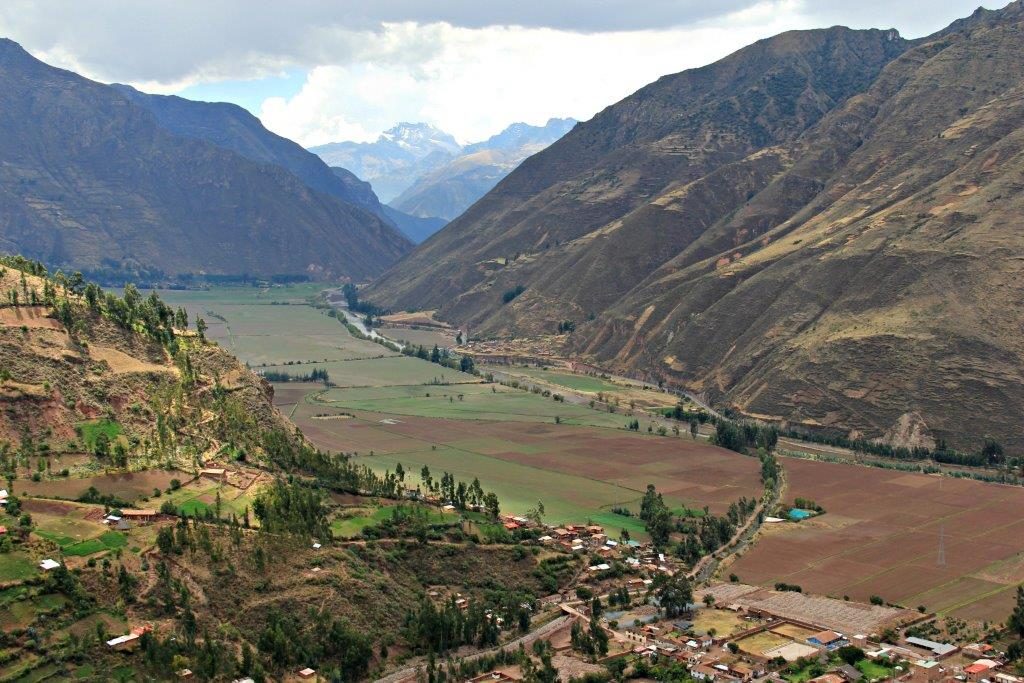
One of the most fascinating aspects of the Sacred Valley of Peru is how much of the ancient ways of life still continue today and also how much is still unknown about the Inca civilization. It is a trip back in time. Yes, there is a lot of new infrastructure to accommodate tourism, but there is a lot still the same as it has been for hundreds of years including agriculture, weaving, and the traditional dress. Add to this the mysticism of the Incas and it is definitely worthy of spending a few days to explore the secrets of the Sacred Valley..
The Sacred Valley is at a lower altitude (1,970 feet or 600 meters) than Cusco’s lofty 11,000 feet (3353 meters) so beginning your trip here can help you adjust to the altitude as well. And don’t underestimate the impact of the altitude especially if you live at sea level. Later in the month we share tips for traveling around Peru including altitude sickness. Just use the form at the bottom of this article or the one in the sidebar and subscribe to the newsletter and you’ll get all the feature coverage of Peru delivered straight to your inbox.
Explore the Ruins of the Incas
There are large complexes of Incan ruins at Ollaytaytambo, Pisac and Chincero. Ollaytaytambo is one of the best preserved. Historians believe this was an important fortress for the Incas.
While a lot is still unknown about the Incas and their civilization, they were prolific builders. The construction methods feature the precision engineering for which the Incas are known. How they were able to cut the stone with such precision without modern tools has fascinated historians. Inca construction relies on cutting the stone to fit precisely; no mortar is used in the stone work. Trapezoidal doors are also a common feature. Many of these ruins have withstood numerous large earthquakes while newer construction methods crumbled.
Equally impressive is their understanding of astronomy including creating a precise calendar and designing buildings to perfectly align to the solstice. There are still many secrets to uncover about this ancient civilization.
The small town of Ollaytaytambo is very busy. Trains leave from here and Cusco to go to Aguas Calientes, the closest town to Machu Picchu.
Another of the Inca’s major cities is Chinero, at 12,500 feet (3,800 meters) it is one of the highest villages in the Sacred Valley. Inca legend names it as the “birthplace of the rainbow.”
Pisac also has an extensive complex of ruins, not as well preserved as Ollaytaytambo, but easy to reach from Cusco.
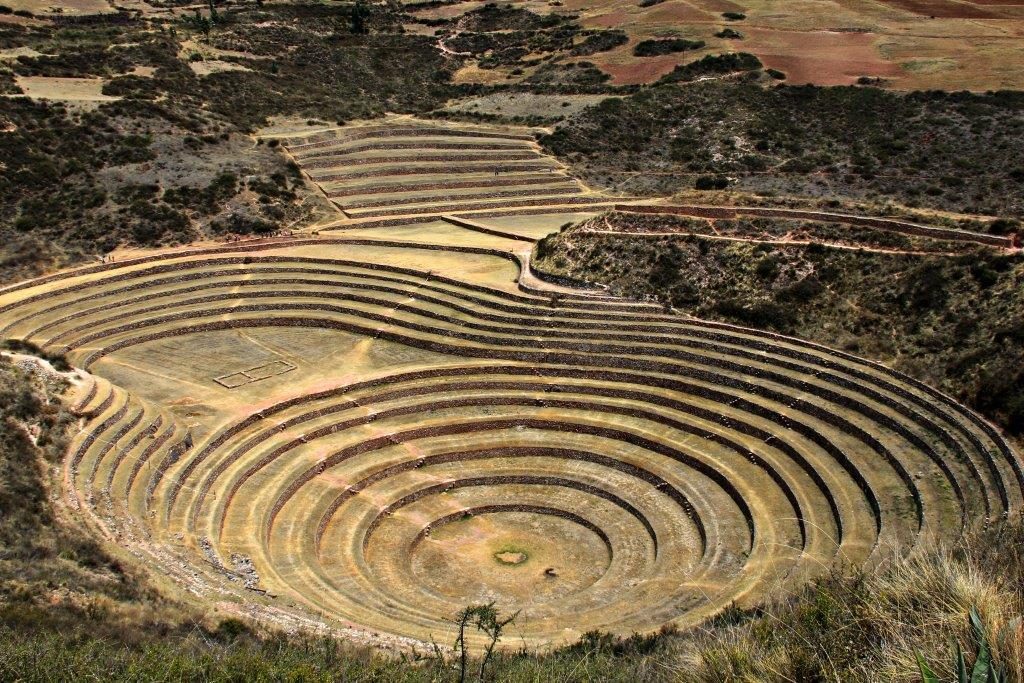
Learn about Ancient Agriculture
Moray is an interesting Inca site near the town of Moras. It is not ruins, but rather a series of concentric circles dug into the ground. From top to bottom, some 500 feet, the temperature varies from 25°-60°F. Archaeologists believe this is where the Inca’s experimented with agriculture, testing which plants and crop species grew best at various temperatures.
As you travel through the Sacred Valley it is amazing to see how much of the land is used for farming. This is at 10,000+ feet in altitude. In many places at this altitude the ground would be covered with snow or have too short a growing season for food production, not in the Sacred Valley. Fertile soil combined with the Río (river) Urubamba which winds through the valley means the Sacred Valley has long been one of Peru’s most fertile regions for agriculture.
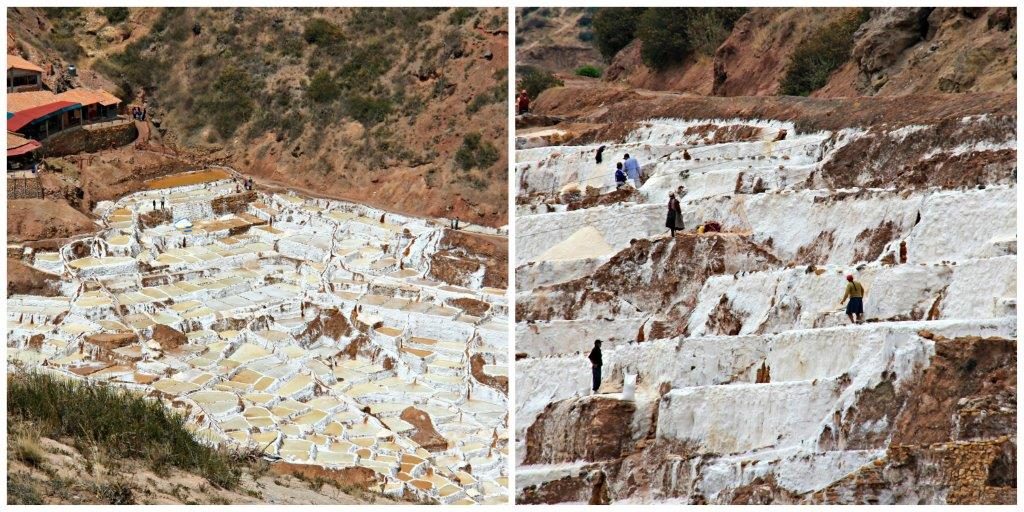
The Incas also developed salt mines, Salineras de Maras to produce salt over 500 years ago. They are still in use today. The mine consists of a series of terraced pools (or salt pans) cut into the mountain side. As the water, which contains the salt crystals, evaporates, the salt is left. Families have allocated areas of the mine and work collecting the salt for sale. For many families this is their income, and has been for generations. The salt terraces are extensive, with over 6,000 small shallow pools on the side of the mountain. You can walk through the terraces and watch them at work. We hiked up through the valley, through the salt mines. Along the way you pass many locals (and their donkeys) as they go about their daily lives.
Tip: A good day trip is to combine Moray, the town of Maras, and the Salineras de Maras together.
Visit a Weaving Cooperative
There are a few cooperatives within the Sacred Valley showcasing the traditional methods of weaving using alpaca wool and natural dyes. Some suggestions:
Awanakancha
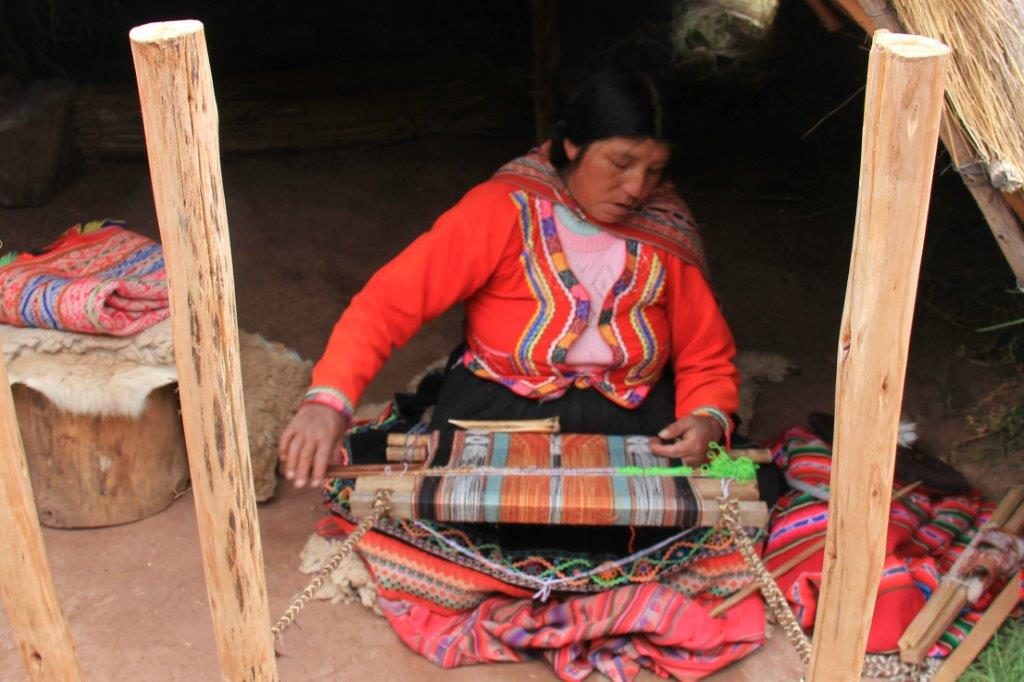 Awanakancha is a cooperative of a number of village families. It is perhaps the most comprehensive option. You can see live alpaca, view how the wool is cleaned, spun and dyed, and the process of weaving. The patterns woven into the textiles are based on cultural stories and animals. The weavers memorize the patterns.
Awanakancha is a cooperative of a number of village families. It is perhaps the most comprehensive option. You can see live alpaca, view how the wool is cleaned, spun and dyed, and the process of weaving. The patterns woven into the textiles are based on cultural stories and animals. The weavers memorize the patterns.
Natural dyes are used to color the wool. How the color red is achieved has a fascinating history. A small insect found on a cactus, the cochinilla, is crushed and used. Historically red was a difficult color to achieve as the materials were not readily available in most of the world. Pure red was therefore very expensive and highly revered. There is a most interesting book examining global history from the perspective of the color red, A Perfect Red: Empire, Espionage, and the Quest for the Color of Desire by Amy Butler Greenfield. It is very well written and details the European’s desire for red and the lengths they went to control it once a source was “discovered” in the Americas.

There is a cafe and a shop at Awanakancha.
Tips: The textiles in the shop are of are very high quality and if you are looking for something extra special to take home this is a good option.
You can stop here on the way from Cusco to Pisac. The town of Pisac also has the abovementioned Incan ruins and a large market on Tuesday, Thursday and Sunday if you want to continue on to Pisac.
Patacancha
About an hour’s drive up a dirt road from Ollytaytambo is the village of Patacancha. This Quechua village, the traditional inhabitants of the area, has remained relatively untouched by modernization. The people still dress in their traditional clothing (which unfortunately is dying out in many villages in Peru) and many speak the local Quechua dialect, not Spanish. Weaving and fish farming cooperatives bring some much needed income into the community. Life continues here as it has for hundreds of years and visitors are a bit of a novelty to the villagers.
Housing is very traditional. We went with one of the local women to see where she lives. Inside of her house she was raising guinea pigs, a Peruvian delicacy known as cuy, for income in addition to her weaving activities.
There is a weaving cooperative where you can buy hand crafted items. The goods are all priced and there is no haggling over price. This is one of the village’s main sources of income.
Chinchero, another good option, also has a large weaving cooperative which has demonstrations and goods for sale.

Visiting the Sacred Valley
Transportation
We organized a car and driver to explore the Sacred Valley. The driver doubled as a tour guide on several of the days, but it was not always the same driver and two of them spoke little English, so we had to rely on our somewhat limited Spanish language skills.
This was a very cost effective option, it allowed us to set our own itinerary and also travel at our own pace. We wanted to do some walking to make sure we were okay at altitude before going on to Cusco and beginning to hike the Inca Trail. Our own driver and itinerary offered us this flexibility.
Our accommodation arranged the driver and included pick-up at the Cusco airport and transfer back to our hotel in Cusco.
There is a somewhat limited bus service between the major towns and there are many day tours through the Sacred Valley.
Acco mmodation
mmodation
The towns in the Sacred Valley all offer accommodation and there is something for every budget. We stayed in at Kuychi rumi, in Urubamba. Urubamba is centrally located in the Sacred Valley and makes a great base to explore for a number of days.
The gardens at the property were lovely. It was quiet, breakfast was generous and good, and the host could not have been more helpful. Each night someone would come and light a fire in the fireplace for us; a great way to end the day. It is a short taxi ride into the town of Urabamba for dinner or each lodge has a full kitchen if you prefer to stay in for the evening.
Tip: South Americans eat dinner late, usually around 9 pm or later.
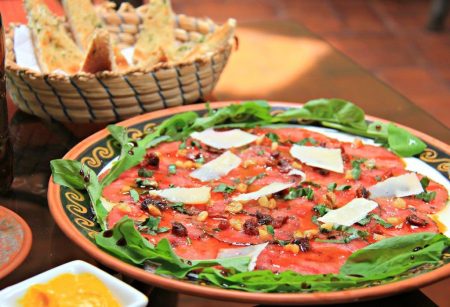 Dining in Urabamba
Dining in Urabamba
We had an afternoon meal at El Huacatay, a restaurant featuring many local specialties. We had an excellent alpaca carpaccio. Eating in the garden makes for a relaxing afternoon. This restaurant is well regarded and was a recommendation from the hosts at our accommodation. If you get the opportunity, we recommend it.
Later in the month there will be another post with full advice about traveling in Peru. Subscribe to the newsletter below and never miss an update.
Do you have any other tips or recommendations for visiting the Sacred Valley? Any other secrets you would like to share? Or perhaps a question? Please leave a comment below.
Please Pin the Secrets of the Sacred Valley for future reference.

 />
/>
Renne Simpson
Saving this for later – I’m going to Sacred Valley on my Peru trip next month. This will be so helpful, thank you!
Editor
Renne, enjoy the Sacred Valley. Lots to do and see.
Sanket D.
Isn’t it enchanting just to imagine how ancient civilisation functions? I loved these pictures, guys; some really great shots.
Editor
I find the whole topic of ancient civilizations fascinating. When you view what the Incas built and the exact nature of how of their geometry, it just leaves you amazed. Thanks for your comment.
Vedante | The Lavish Nomad
My friends just came back from Peru and they said it was amazing! This article and their word of mouth has ow convinced to go to Peru soon 😀
Editor
You won’t regret going to Peru. It is full of surprises and such a diverse geography. Thanks for your comment.
Gemma
Peru really is a special country and that’s a great tip about attitude, it can really set people back a few days on their trip. Ollaytaytambo was beautiful but we didn’t have time to see Pisac, will have to go back! Great post!
Editor
Gemma, glad it brought back some memories for you. I think the altitude does catch some people out, especially those living at sea level. Thanks for your comment
Lauren
It’s certainly a fascinating place. My sister has traveled here before and I’m dying to. I’ve always been so fascinated by the Inca civilization. Can’t wait!! 🙂
Editor
Lauren, you won’t be disappointed. We have some books featuring the Inca civilization here. Thanks for your comment.
Sreeram
Incredible place, I have been wanting to go to this place since quite some time now. Finally managed to draft a rough one year’s itinerary around the Central and South America. Goes without saying, I am bookmarking this helpful page to refer to while I am there. Cheers and Thanks for sharing.
Editor
We have a whole bunch of food and travel in Peru and Patagonia, make sure you get down there as well. Thanks for your comment.
Cai Dominguez
Thank you for sharing this details article. Ive been wanting to visit Peru someday. The place looks like what we have in the northern part of the Philippines.
Editor
Funny you should say that, when I saw the sheep, wheat, eucalyptus trees and the yellow and brown hues of the countryside, we thought we were in Australia! Thanks for your comment
Jessica
Very rich secrets. Love to learn more about the ancient agriculture. Thanks for this, Elizabeth 🙂
Editor
We have some rather good Peruvian books featured. Not a bad a place to learn more about the Incas. Thanks for your comment.
Trisha Velarmino
I spent 3 months volunteering in Sacred Valley and it was a great experience! I also had a chance to do Ayuhuasca in this area — one of the greatest things I’ve done in SV! Thanks for sharing!
Editor
Hi Trisha. Good for you on the Ayuhuasca! We found the Sacred Valley remarkable in that it was/is a major food bowl for Peru. I’m still having trouble working out how wheat grows up there given the very high altitude. It also reminded me of Australia, the colors, the eucalyptus, the sheep. Thanks for your comments.
Tracie Howe
I’ve always been worried about how the altitude would affect me whenever I end up going to Machu Pichu. This seems like such a lovely place to adjust to the altitude. Those salt mine pools remind me so much of the tanning pools in Fez, Morocco! Thanks for sharing!
Editor
Tracie, you are right on the money there. I was very glad we acclimated in the Sacred Valley and then Cusco before we attempted the Inca Trail. Thanks for your comment.